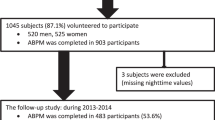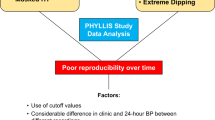Abstract
Because oxidative stress and inflammation are known to play important roles in the pathogenesis of cardiovascular events that occur most frequently in the morning, we studied the association between reactive oxygen species (ROS) formation by polymorphonuclear leukocytes (PMNs) or mononuclear cells (MNCs) and morning blood pressure (BP) rhythm. A total of 31 hypertensives in whom ambulatory BP monitoring was performed participated in this study. They were first divided into three groups according to their nocturnal BP rhythm (non-dippers, dippers and extreme dippers), and then into two groups according to their morning BP change (surge-type and sustained-type). ROS formation by PMNs and MNCs was measured by gated flow cytometry. C-reactive protein and traditional risk factors such as age, gender, body mass index, hemoglobin A1c, and total cholesterol were also measured. ROS formation by MNCs was significantly increased in extreme dippers (vs. dippers, p<0.05, n=11) and in morning BP surge-type hypertensives (vs. sustained-type, p<0.05, n=13). In patients who were both extreme dippers and morning BP surge-types, ROS formation by MNCs was significantly higher than that in other groups. These results suggest that both extreme dippers and morning BP surge-type hypertensives may suffer increased ROS formation by MNCs, and that increased ROS formation by MNCs may underlie morning strokes.
Similar content being viewed by others
Article PDF
References
Kario K, Matsuo T, Kobayashi H, Imiya M, Matsuo M, Shimada K : Nocturnal fall of blood pressure and silent cerebrovascular damage in lderly hypertensive patients: advanced silent cerebrovascular damage in extreme-dippers. Hypertension 1996; 27: 130–135.
Kario K, Pickering TG, Umeda Y, et al: Morning surge in blood pressure as a predictor of silent and clinical cerebrovascular disease in elderly hypertensives. A prospective study. Circulation 2003; 107: 1401–1406.
Willich SN, Goldberg RJ, Maclure M, Perriello L, Muller JE : Increased onset of sudden cardiac death in the first three hours after awakening. Am J Cardiol 1992; 70: 65–68.
Muller JE, Tofler GH, Stone PH : Circadian variation and triggers of onset of acute cardiovascular disease. Circulation 1989; 79: 733–743.
White WB : Cardiovascular risk and therapeutic intervention for the early morning surge in blood pressure and heart rate. Blood Press Monit 2001; 6: 63–72.
Zheng Z, Lee JE, Yenari MA : Stroke: molecular mechanisms and potential targets for treatment. Curr Mol Med 2003; 3: 361–372.
Bowler RP, Sheng H, Enghild JJ, Pearlstein RD, Warner DS, Crapo JD : A catalytic antioxidant (AEOL 10150) attenuates expression of inflammatory genes in stroke. Free Radic Biol Med 2002; 33: 1141–1152.
Ishibashi N, Prokopenko O, Reuhl KR, Mirochnitchenko O : Inflammatory response and glutathione peroxidase in a model of stroke. J Immunol 2002; 168: 1926–1933.
Yasunari K, Maeda K, Nakamura M, Yoshikawa J : Oxidative stress in leukocytes is a possible link between blood pressure, blood glucose, and C-reacting protein. Hypertension 2002; 39: 777–780.
Maeda K, Yasunari K, Sato EF, Yoshikawa J, Inoue M : Activation of protein kinase C and nicotinamide adenine dinucleotide phosphate oxidase in leukocytes of spontaneously hypertensive rats. Hypertens Res 2003; 26: 999–1006.
Smedly LA, Tonnesen MG, Sandhaus RA, et al: Neutrophil-mediated injury to endothelial cells: enhancement by endotoxin and essential role of neutrophil elastase. J Clin Invest 1986; 77: 1233–1243.
Weiss SJ : Tissue destruction by neutrophils. N Engl J Med 1989; 320: 365–376.
Jialal I, Devaraj S, Kaul N : The effect of α-tocopherol on monocyte proatherogenic activity. J Nutr 2001; 131: 389S–394S.
Beray-Berthat V, Palmer B, Plotkine M, Margaill I : Neutrophils do not contribute to infarction, oxidative stress, and NO synthase activity in severe brain ischemia. Exp Neurol 2003; 182: 446–454.
Lerouet D, Beray-Berthat V, Palmier B, Plotkine M, Margaill I : Changes in oxidative stress, iNOS activity and neutrophil infiltration in severe transient focal cerebral ischemia in rats. Brain Res 2002; 958: 166–175.
Danton GH, Dietrich WD : Inflammatory mechanisms after ischemia and stroke. J Neuropathol Exp Neurol 2003; 62: 127–136.
Bass DA, Parce JW, Dechatelet LR, Szejda P, Seeds MC, Thomas M : Flow cytometric studies of oxidative product formation by neutrophils: a graded response to membrane stimulation. J Immunol 1983; 130: 1910–1917.
Yasunari K, Kohno M, Kano H, Minami M, Yokokawa K, Yoshikawa J : Antioxidants improve impaired insulin-mediated glucose uptake and prevent migration and proliferation of cultured rabbit coronary smooth muscle cells induced by high glucose. Circulation 1999; 99: 1370–1378.
Rausch M, Sauter A, Frohlich J, Neubacher U, Radu EW, Rudin M : Dynamic patterns of USPIO enhancement can be observed in macrophages after ischemic brain damage. Magn Reson Med 2001; 46: 1018–1022.
Yasunari K, Maeda K, Nakamura M, Watanabe T, Yoshikawa J : Benidipine, a long-acting calcium channel blocker, inhibits oxidative stress in polymorphonuclear cells in patients with essential hypertension. Hypertens Res 2005; 28: 107–112.
Zheng Z, Lee JE, Yenari MA : Stroke: molecular mechanisms and potential targets for treatment. Curr Mol Med 2003; 3: 361–372.
Mehta JL, Lopes LM, Chen L, Cox OE : Alterations in nitric oxide synthase activity, superoxide anion generation, and platelate aggregation in systemic hypertension, and effect of celiprolol. Am J Cardiol 1994; 74: 901–905.
Pontremoli S, Salamino F, Sparatore B, De Tullio R, Patrone M, Tizianello A : Enhanced activation of the respiratory burst oxidase in neutrophils from hypertensive patients. Biochem Biophys Res Commun 1989; 158: 966–972.
Panza JA, Epstein SE, Quyyumi AA : Circadian variation in vascular tone and its relation to alpha-sympathetic vasoconstrictor activity. N Engl J Med 1991; 325: 986–990.
Pickering TG, Levenstein M, Walmsley P, for the Hypertension and Lipid Trial Study Group : Nighttime dosing of doxazosin has peak effect on morning ambulatory blood pressure: results of the HALT Study. Am J Hypertens 1994; 7: 844–847.
Muller JE, Tofler GH, Stone PH : Circadian variation and triggers of onset of acute cardiovascular disease. Circulation 1989; 79: 733–743.
Muller JE, Abela GS, Nesto RW, Tofler GH : Triggers, acute risk factors, and vulnerable plaques: the lexicon of a new frontier. J Am Coll Cardiol 1994; 23: 809–813.
Kario K, Matsuo T, Kobayashi H, Yamamoto K, Shimada K : Earthquake-induced potentiation of acute risk factors in hypertensive patients: possible triggering of cardiovascular events after a major earthquake. J Am Coll Cardiol 1997; 29: 926–933.
Author information
Authors and Affiliations
Corresponding author
Rights and permissions
About this article
Cite this article
Maeda, K., Yasunari, K., Watanabe, T. et al. Oxidative Stress by Peripheral Blood Mononuclear Cells Is Increased in Hypertensives with an Extreme-Dipper Pattern and/or Morning Surge in Blood Pressure. Hypertens Res 28, 755–761 (2005). https://doi.org/10.1291/hypres.28.755
Received:
Accepted:
Issue date:
DOI: https://doi.org/10.1291/hypres.28.755
Keywords
This article is cited by
-
Short-term blood pressure variability as a potential therapeutic target for kidney disease
Clinical Hypertension (2023)
-
An exaggerated blood pressure response to exercise is associated with nitric oxide bioavailability and inflammatory markers in normotensive females
Hypertension Research (2016)
-
Infliximab, a TNF-α inhibitor, reduces 24-h ambulatory blood pressure in rheumatoid arthritis patients
Journal of Human Hypertension (2014)
-
DNA damage and oxidative status in newly diagnosed, untreated, dipper and non-dipper hypertensive patients
Hypertension Research (2013)
-
Disturbed circadian blood pressure rhythm and C-reactive protein in essential hypertension
Journal of Human Hypertension (2008)



